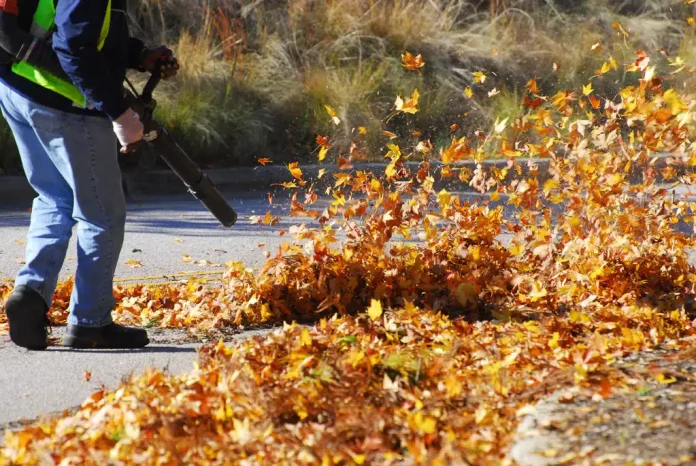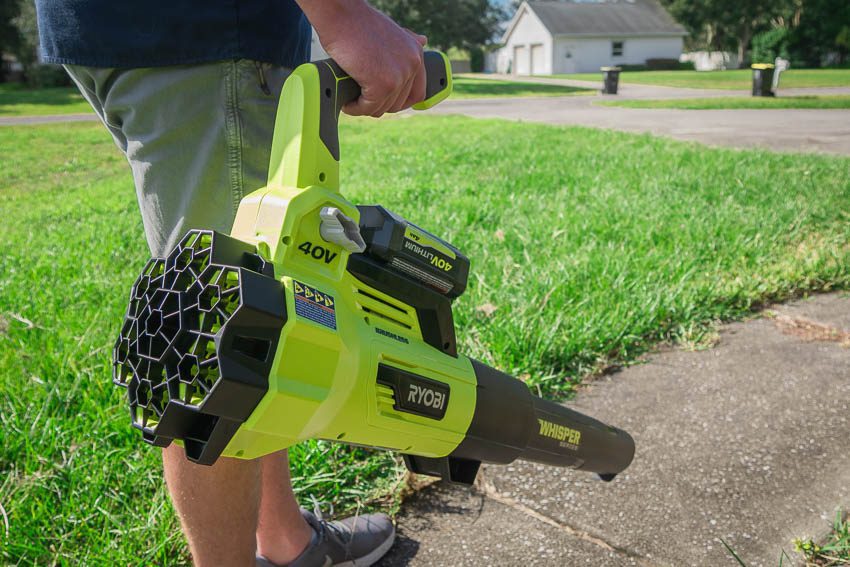Curious about whether or not you should wear a mask when operating a leaf blower?
We’ve got the answer for you! In this article, we’ll explore the potential hazards of using a leaf blower and provide valuable insights on how wearing a mask can help protect your health. So, please sit back, relax, and clear the air on this leafy matter!
Health Risks of Using a Leaf Blower
Using a leaf blower may seem harmless, but it can pose several health risks. One of the main concerns is the irritation it can cause to the respiratory system. The powerful air stream generated by a leaf blower can stir up dust particles, pollen, and other allergens, which can be inhaled and irritate the lungs and airways. This can lead to coughing, wheezing, and difficulty breathing.
In addition to respiratory irritation, leaf blowers expose users to pollen and allergens. For individuals who suffer from allergies or asthma, this can trigger symptoms such as sneezing, a runny nose, and itchy eyes. Furthermore, inhaling dust and debris can also cause some individuals’ eye irritation and allergic reactions.
Types of Masks for Leaf Blower Use
Wearing a mask can be highly beneficial when protecting oneself from the health risks associated with using a leaf blower. Several types of masks are suitable for leaf blower use, each with its own level of protection.
Disposable dust masks are a popular choice for leaf blower users. These masks are lightweight, affordable, and protect against dust particles. They typically have a simple design with a metal nose clip to ensure a secure fit.
N95 respirators provide more filtration and protection than disposable dust masks. These masks can filter out at least 95% of airborne particles, including pollen, dust, and hazardous chemicals. N95 respirators are designed to form a tight seal against the face to prevent leakage.
Half-face respirators can be a suitable option for those requiring even more comprehensive protection. These respirators cover the nose and mouth and offer a higher level of filtration than disposable dust masks or N95 respirators. They are equipped with replaceable filter cartridges that block a wide range of airborne contaminants.
Full-face respirators provide the highest level of protection for leaf blower users. These masks cover the entire face and feature a built-in visor to protect the eyes. They offer respiratory and eye protection, making them ideal for individuals exposed to hazardous chemicals or materials during leaf-blowing activities.
Effectiveness of Masks
Masks worn during leaf blower use serve several purposes. Firstly, they protect from dust particles that the powerful airflow of the blower can stir up. Appropriate masks can significantly reduce dust particles, preventing them from entering the respiratory system and causing irritation.
In addition to dust particles, masks effectively filter pollen and other allergens from the air. This is particularly important for individuals with allergies or asthma, as exposure to these allergens can trigger symptoms such as sneezing, runny nose, and itchy eyes. Wearing a mask can help minimize the inhalation of these irritants and relieve those affected.
Furthermore, masks can also block harmful chemicals and fumes that may be present in the air while using a leaf blower. This is especially relevant for individuals who work in landscaping or gardening, as they may come into contact with pesticides or other toxic substances. Appropriate masks can reduce the risk of inhaling these chemicals and protect the respiratory system.
Considerations for Mask Selection
When choosing a mask for leaf blower use, it is essential to consider several factors to ensure its effectiveness and comfort.
Fit and seal are crucial aspects to consider when selecting a mask. It is essential that the mask fits securely over the face and forms a tight seal to prevent any leakage. This ensures that all the air being breathed in passes through the mask’s filtration system, maximizing its effectiveness.
Comfort and breathability are also crucial considerations, as the mask should be comfortable for extended periods. Masks that are too tight or restrict breathing can cause discomfort and may discourage consistent use. Finding a mask that balances effective filtration and ease of wear is essential.
Another factor to consider is the duration of use. If the leaf-blowing task is expected to be of relatively short duration, disposable masks may be a suitable choice. However, reusable masks with replaceable filters can be more economical and environmentally friendly for longer tasks or frequent use.
Common Symptoms and Health Issues
Inhaling dust, pollen, and other irritants while using a leaf blower can lead to various symptoms and health issues. Coughing and wheezing are common respiratory symptoms that may arise due to the irritation caused by these airborne particles. Sneezing and a runny nose can also occur, especially in individuals allergic to pollen or other allergens.
Eye irritation is another common issue from using a leaf blower without proper protection. The dust and debris blown around can cause redness, itchiness, and watering of the eyes. In some cases, individuals may also experience allergic reactions, such as hives or skin rashes, due to exposure to allergens present in the air.
Proper Usage of Masks
A mask is insufficient to ensure protection while using a leaf blower. Using the mask correctly and following proper guidelines is essential to maximize effectiveness.
Firstly, the mask should be worn properly, with the nose piece securely fitted over the nose and the straps or headgear adequately adjusted to create a seal. This helps prevent unfiltered air from entering gaps between the mask and the face.
Ensuring a tight seal is crucial for effective filtration and protection. The mask should fit snugly against the face, completely covering the nose and mouth. Checking for leaks or gaps during use and readjusting the mask if necessary can help maintain a proper seal.
Avoiding contamination is also essential when using a mask for leaf blower activities. Handling the mask carefully, especially after use, is essential to prevent touching the front surface that may have come into contact with contaminants. Washing hands thoroughly before and after handling the mask can also help prevent the spread of germs.
Taking breaks and staying hydrated is essential when using a mask for prolonged periods. Masks can make breathing feel slightly more labored, so listening to one’s body and taking short breaks to rest and rehydrate is essential. This can help prevent discomfort and ensure optimal respiratory function.
Alternatives to Masks
While masks offer adequate protection against the health risks of using a leaf blower, alternative measures can be taken to minimize exposure to airborne particles and allergens.
Using a leaf blower with a HEPA filter is one such alternative. HEPA filters can capture particles as small as 0.3 microns with a high efficiency. A leaf blower equipped with a HEPA filter can significantly reduce the amount of airborne particles and allergens, resulting in a cleaner and safer environment.
Clearing the area before use is another simple yet effective measure. Removing debris, dust, or allergens from the area where the leaf blower will be used reduces the amount of particles that can be stirred up and inhaled. This can help minimize the risk of respiratory irritation and allergic reactions.
Considering the time of operation and wind direction is also essential. Choosing to use the leaf blower when pollen counts are lower and winds are calmer can help reduce exposure to allergens. By being mindful of these factors, individuals can minimize their risk of symptoms and discomfort.
Safety Precautions while Using a Leaf Blower
In addition to wearing masks or using alternative measures, several safety precautions should be followed when using a leaf blower to minimize the risk of accidents and further health issues.
Protective clothing and eyewear are recommended to shield the body and eyes from flying debris. Long sleeves, pants, and closed-toe shoes can help protect the body, while safety goggles or glasses can prevent eye injuries.
Maintaining a safe distance from bystanders is crucial to avoid causing harm. Leaf blowers can generate powerful gusts of wind, blowing objects at high speeds. Ensuring no individuals or animals are near the blowing area can prevent accidents and injuries.
Avoiding fumes and exhaust is another necessary precaution. Gas-powered leaf blowers emit fumes that can be harmful when inhaled. Using these blowers in well-ventilated areas is essential to minimize exposure to exhaust gases. Electric leaf blowers are a safer alternative in terms of minimizing harmful emissions.
Cleaning and maintaining the leaf blower are also essential to ensure safe operation. Regularly cleaning and inspecting the blower for any damages or malfunctions can prevent accidents and improve its lifespan. Following the manufacturer’s instructions for maintenance and storage is highly recommended to ensure proper functioning.
Legal Requirements and Regulations
Before using a leaf blower, it is essential to be aware of any legal requirements and regulations set forth by local authorities. This can help avoid potential fines or penalties and contribute to the overall well-being of the community and environment.
Local noise restrictions might limit the use of leaf blowers during certain times of the day or week. It is essential to familiarize oneself with these restrictions and adhere to them to respect noise regulations and minimize disturbance to others.
In some areas, municipal bans on leaf blowers might be in place. These bans are usually implemented to reduce noise pollution and protect the environment. It is essential to be aware of any such bans and explore alternative methods of clearing leaves and debris if necessary.
Environmental protection guidelines may also be in effect to minimize the impact of leaf-blowing activities on the ecosystem. These guidelines may include recommendations for proper debris disposal, restrictions on blowing debris into water bodies, or guidelines for minimizing dust and pollution. Staying informed and following these guidelines can help preserve the environment and promote sustainable practices.
Professional Recommendations
In addition to the considerations above and precautions, professional recommendations can help guide individuals in choosing the appropriate protective measures when using a leaf blower.
The Occupational Safety and Health Administration (OSHA) provides guidelines for respiratory protection in various industries. These guidelines can be a valuable resource for individuals who work in landscaping or gardening and may be exposed to airborne contaminants during leaf-blowing activities.
Seeking advice from landscaping experts can also provide valuable insights into the best practices and equipment for leaf blower use. Experienced professionals in the field can offer recommendations on masks, alternative measures, and safety precautions based on their expertise and experience.
Public health recommendations, such as those provided by health organizations or medical professionals, can also be beneficial in making informed decisions regarding leaf blower use. These recommendations may include guidelines for protecting respiratory health, minimizing allergen exposure, and promoting overall well-being.
In conclusion, wearing a leaf blower mask is highly recommended to protect against the health risks of airborne particles, pollen, and allergens. Choosing the appropriate mask, considering factors such as fit, comfort, and duration of use, can ensure maximum effectiveness and optimal respiratory protection.
Additionally, following safety precautions, exploring alternative measures, and adhering to legal requirements and regulations can contribute to a safer and more environmentally friendly leaf-blowing experience. By prioritizing respiratory health and taking the necessary precautions, individuals can enjoy the benefits of using a leaf blower while minimizing the potential harm to their health and the environment.



































